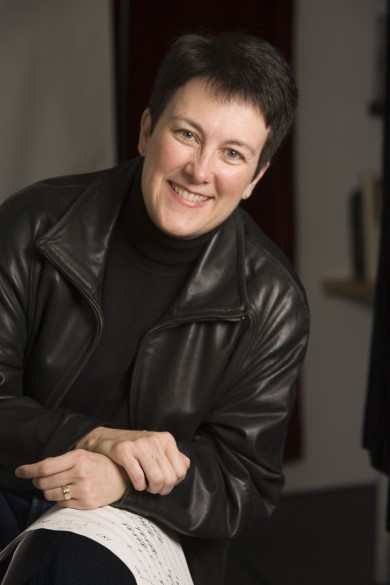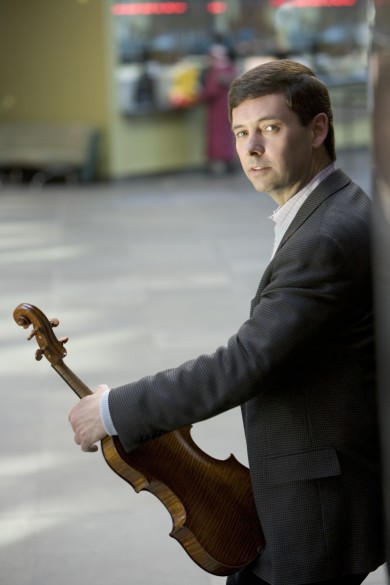Diaz and Spano bring Higdon’s new Viola Concerto to Miami

Jennifer Higdon’s Viola Concerto will be performed Wednesday night at Gusman Concert Hall. Photo: J.D. Scott.
The lowest form of humor may be the pun. But for classical musicians, it’s the viola joke.
How can you tell a violist is playing out of tune? His bow is moving. How do you keep your violin from being stolen? Put it in a viola case. Why don’t violists play hide and seek? Because no one would look for them.
The image of the violist was that of a failed violinist, someone who switched to the lower-pitched instrument for the opportunity to play the undemanding interior parts of symphonies and string quartets.
But if that was never an accurate picture of violists or the music they played, it’s even more divorced from reality today, now that a number of virtuoso violists have emerged, inspiring composers to write concertos, sonatas and other works for their instrument. (Viola jokes live on, however, and no one tells them more than violists.)
The latest addition to the viola repertoire will be unveiled in South Florida Wednesday night at the University of Miami’s Gusman Hall, when the viola virtuoso Roberto Díaz performs a new concerto by the renowned American composer Jennifer Higdon. Accompanying Díaz will be the Curtis Chamber Orchestra conducted by Robert Spano. Also on the program, which is being presented by Friends of Chamber Music of Miami, are Prokofiev’s Symphony No. 1 and Mozart’s Symphony No. 41, and three songs composed by Spano performed by soprano Rachel Sterrenberg.
Higdon, 52, is among the best-known of today’s composers. Winner of the 2010 Pulitzer Prize for her Violin Concerto, she has been commissioned to compose for many major orchestras. Her most widely performed works, such as the tone poem blue cathedral, have achieved great popularity among listeners. Her music, colorful, melodic, largely tonal and with a strong sense of musical architecture, appeals to listeners’ minds and hearts while sounding absolutely contemporary and American.
“It has vitality, energy, immediacy, it pops,” said Spano, a leading interpreter of Higdon’s music. “Living for a long time with pieces of hers, I feel they get richer and deeper. It’s an interesting combination. With a lot of pieces that have immediate appeal, you eventually want them to go away.”
Higdon composed the concerto in Philadelphia, where she teaches composition at the Curtis Institute of Music, where Díaz serves as president and Spano is an alumnus.
“When I’m writing my music, I write it like even if you’ve never been to a classical concert, the piece should be able to speak to you,” said Higdon. “And if you know a lot about classical music the piece should still speak to you. You don’t need a PhD to understand it.”
She composed the Viola Concerto on a commission from the Library of Congress, Nashville Symphony, Curtis Institute and the Aspen Music Festival. The lead commissioner was the Library of Congress, which wanted a work to show off a Stradivarius viola it holds on a long-term loan from the Baird family of Buffalo. Known as the Tuscan-Medici viola, it was built in 1690 as part of a quartet of instruments for Prince Ferdinando de’ Medici, an influential patron of music.
The world premiere took place this past Saturday at the Library of Congress in Washington, D.C. After that, Díaz, Spano and the Curtis orchestra will take the work on tour, including a concert at the University of Miami. The Library of Congress’ Stradivarius will not join them. Instead Díaz will play his own instrument, a 400-year-old Amati that once belonged to the great 20th-century violist William Primrose.
Asked to describe the concerto, Higdon said, “It’s probably closer to the vein of blue cathedral, the slower music. The middle movement is like a scherzo. It has a very American swing to it. It’s very tuneful, a very clear pulse, a lot of color in the in orchestra backing up the viola. I wanted it to sound like joyful. Does that make sense? It’s not something you always associate with the viola, but that’s what I was going for.”
She drew inspiration, she said, from Díaz’s playing and from the beauty of the viola’s sound.
“There’s something about the color,” she said. “It has a dark hue, but there’s a color there on the lower part of the instrument that just appeals to my ear. And I think part of this comes from the fact that Curtis has an extraordinary department that trains amazing violists. So I went to school at Curtis in 1986, and from the moment I walked in the door I was very aware of the sound of the viola. They’re just so good there.”
The number of excellent violists today is one of the factors driving the production of new works for the instrument.
Díaz, who will perform the work at the University of Miami, said the flowering of the viola repertoire, which began in the early 20th century and continues today, can be attributed to the work of pioneering virtuosos such as Primrose and Lionel Tertis, as well as great contemporary violists such as Yuri Bashmet and Kim Kashkashian. These performers have shown composers what their instrument is capable of, just as previous virtuosos paved the way for more compositions on the violin, cello and piano.
And so today we have viola concertos by William Walton, Bela Bartók, Miklós Rózsa, Alfred Schnittke and many others. Shostakovich wrote the final work of his life for the instrument, a sonata for viola and piano that takes full advantage of the instrument’s ability to express the darker spectrum of emotions.
“When you have people that are playing at a certain level, then it attracts composers to write music for them,” Díaz said. “Beethoven wrote the piano concertos for himself, and Mozart did too. When viola players started really developing their ability on the instrument, you start seeing the composers will take advantage of that, which is fantastic.”
As for viola jokes, he offered this one: How can you tell the stage is level? Drool is coming out of both sides of the violist’s mouth.
He described Higdon’s work as a difficult one. “It runs around all over the instrument,” he said. “Very high, fast things, and she really kind of pushes the envelope with the high register, which is nice, actually, but depending on the instrument you’re playing on, it’s not always easy to navigate these things. We’re very excited about the birth of this new piece, and it’s been a lot of fun to work on.”
Jennifer Higdon’s Viola Concerto will be performed 8 p.m. Wednesday at the University of Miami’s Gusman Hall on the Friends of Chamber Music of Miami series. miamichambermusic.org; 305-372-2975.
